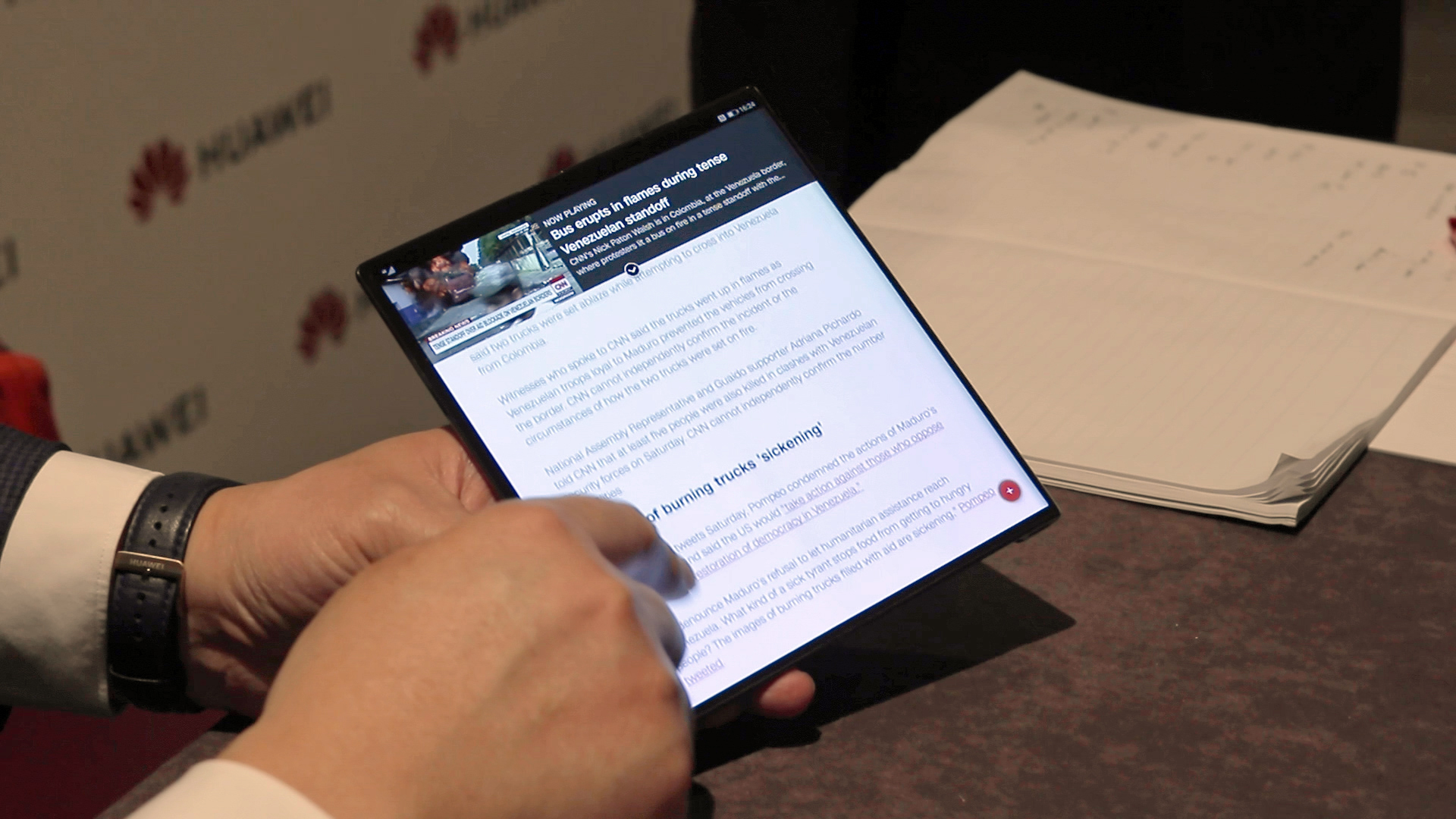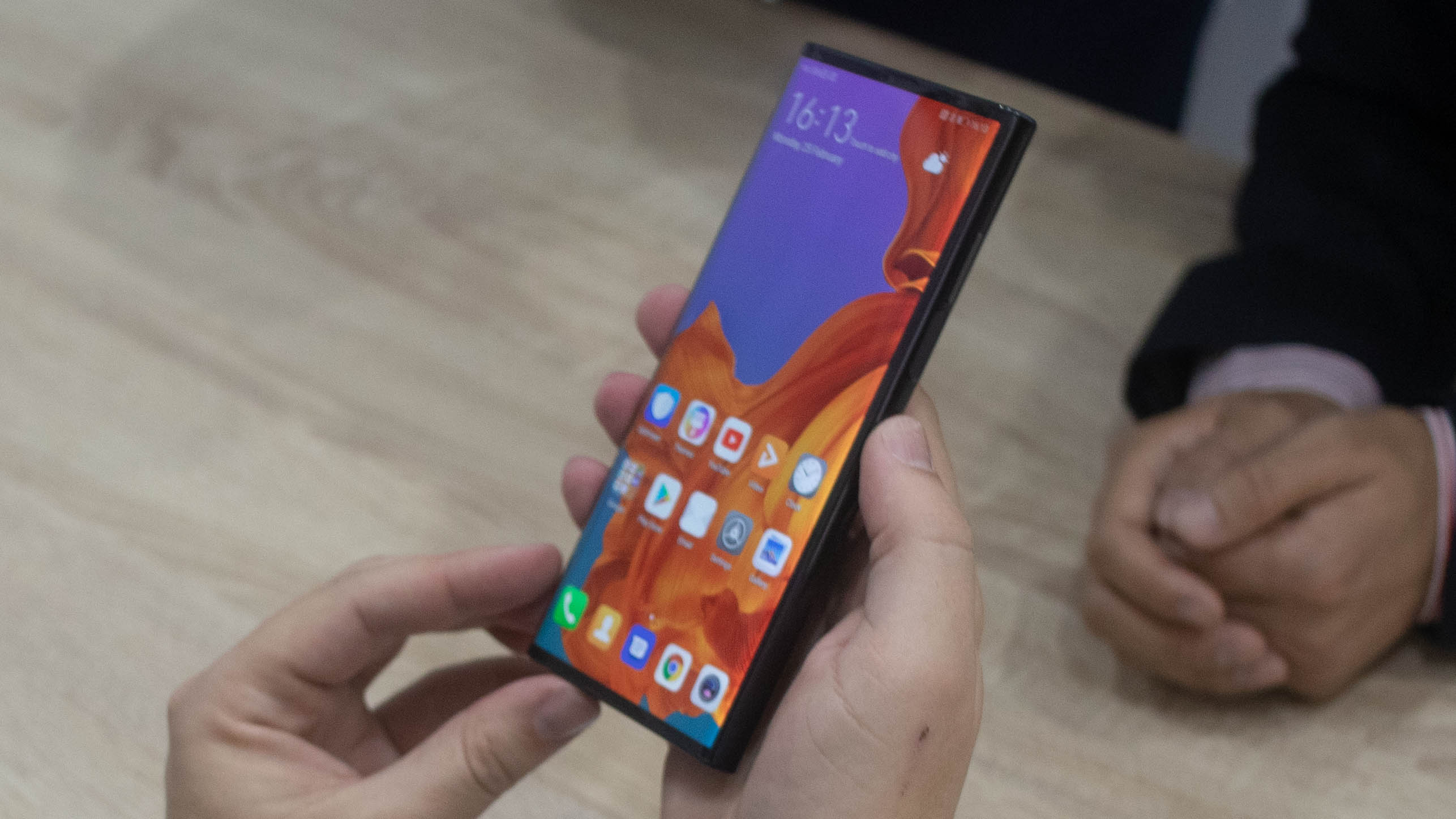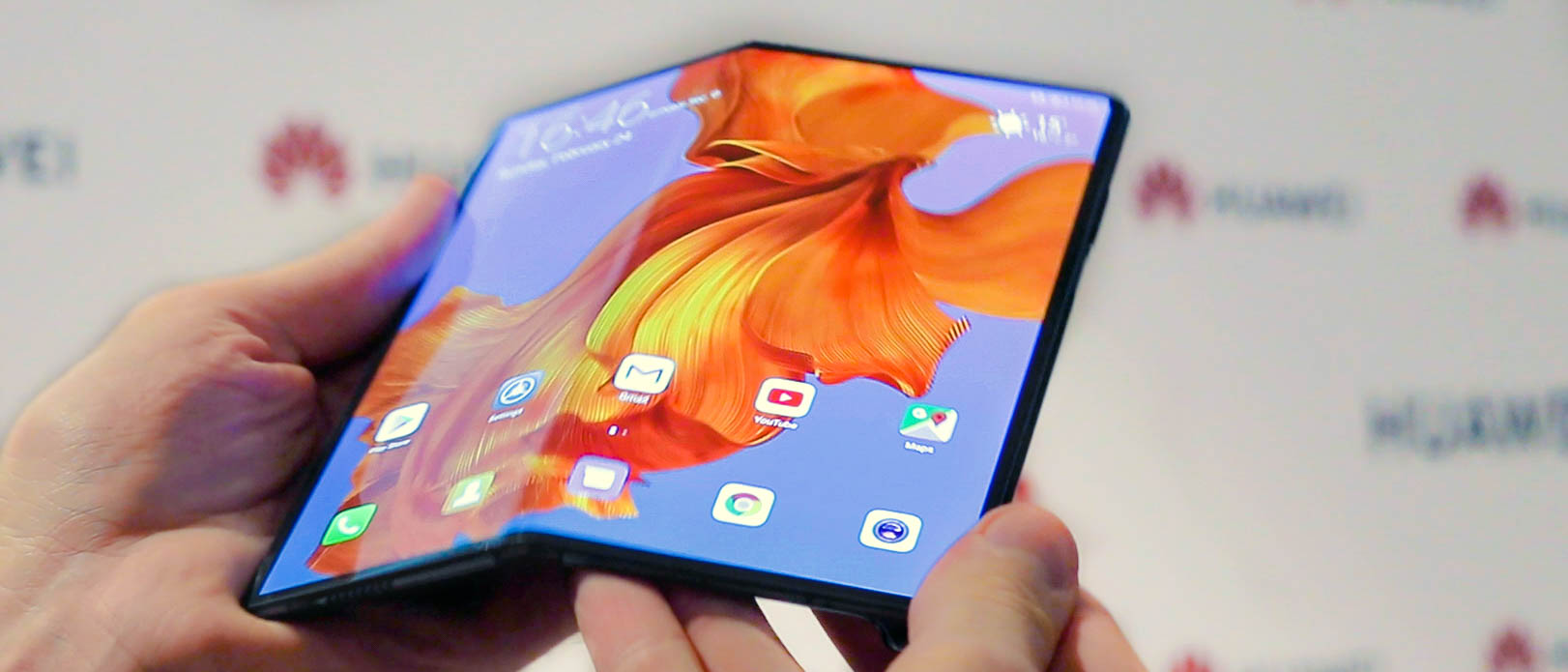Early Verdict
The Huawei Mate X might be the first foldable phone you seriously consider paying gobs of money for in 2019. Its solid-feeling hinge allows this handset to fold up, transforming from full 8-inch tablet into a more-traditional-looking 6.6-inch and 6.38-inch smartphone with a screen on either side. It feels like you're holding the future in your hand, just know that your transformative euphoria over this phone comes at a very high price.
Pros
- +
Folds with two large outer screens
- +
Expands into an 8-inch tablet
- +
Hinge feels solid in hand
- +
High-powered specs
Cons
- -
Mid-crease occasionally reflects light
- -
Very expensive
Why you can trust TechRadar
The Huawei Mate X is the foldable phone our sci-fi imaginations dreamed up years ago, and, yes, it's been in our hands and will be ready to launch by the end of 2019.
Our extended Mate X hands-on review time proves it that has a solid-feeling hinge in order to transform from a phone with 6.6-inch and 6.38-inch screens on either side into a full 8-inch Android tablet.
It's Huawei's FullView bezel-reduced screen that makes this foldable phone look better than the Samsung Galaxy Fold that's scheduled to launch this month. And, in the face of delays, it's gotten a power boost to compete with its foldable rival.
The Huawei Mate X will come in two variants, TechRadar found at IFA 2019, and both have serious horsepower backing up the high expectations of such an expensive device. The original version with Huawei's Kirin 980 chipset, which we saw back in February, will be joined by a souped-up 5G Mate X with the Kirin 990 chip.
The Mate X camera array has also been tweaked: it now uses the sensors and lenses from the Huawei P30 rather than the Mate 20.
How did it feel each time we tested it? What's it going to be like to use? When it that elusive release date? Here's an updated look at what we think and what we know.
Editor's note: After Google suspended Huawei's future access to Android Play Store and security updates, there are serious question marks over the future of Huawei and Honor phones.
Sign up for breaking news, reviews, opinion, top tech deals, and more.
While Google and Huawei have promised to support phones currently on the market, it's not clear how long they'll receive Android updates or access to the Google Play Store, which would severely curtail their usefulness compared to the competition.

Price and release date
Huawei’s Mate X dropped with gusto at MWC 2019, and with a price tag that makes the highest-specced iPhone look affordable; Huawei, once synonymous with budget devices, is most definitely getting comfortable in the big leagues.

The Huawei Mate X price is €2,299, which converts to about $2,600, £2,000, AU$4,770 with 512GB of internal storage and 8GB of RAM, and Huawei has hinted there will be other variants down the line.
This foldable phone will launch in the UK on EE, Three and Vodafone at some point in 2020. At the moment it seems like a November release date is most likely, though the company's Chinese support team did mention it could drop in October there.
The Mate X launched on October 23 in China, which made it look like a global launch could be imminent, however at the moment there's no word on this. The price tag in China converted to a lower price than the aforementioned Euro cost, but that doesn't necessarily mean the device will be available for cheaper than we expected, just that it'll be priced differently in different regions.
That doesn't mean The Mate X will launch everywhere. As revolutionary as this foldable phone looks, there are no US release date plans, said Huawei reps, meaning you may have to import this 2-in-1 5G device to get it in North America.
Design and screen
One thing that wasn’t made clear in our initial briefing on the Mate X was how the clasp system used to keep the screen firmly flush when the phone is in its folded 'phone state' worked.

It turns out that a button on the back of the phone can be pressed, releasing the back portion of the display so it can be unfurled into an 8-inch tablet.
The front of the phone really is all-screen – 6.6-inches of it, in stark contrast to the Samsung Galaxy Fold’s humble 4.6-inch external display outlined with beefy bezels.
This is where the Mate X really stands out. Samsung's single outer screen in folded mode takes us back to the days of heavy bezel outlines and small displays, just when we got to favorable screen-to-body ratios on phones. Huawei skips ahead with its FullView 8-inch display.

Turn the Mate X around and its back portion – the rest of the display, creates a secondary 6.4-inch screen that’s thinner – this could be cool for watching 21:9 movies, activating the smallest display, and potentially saving battery.
The reason this could save battery comes down to the Mate X's screen technology. As this is an OLED display individual pixels can be fired up, with unused pixels remaining pitch black; this is in contrast to LCD displays that require the whole panel – all the pixels – to be illuminated simultaneously.
Huawei capitalizes on this power-saving feature innate to OLED tech in the core design of its Mate X.

Back to that design, and to the left of the rear screen is a vertical bar. This houses the brains of the operation, from the triple-camera system – which Huawei was very tight-lipped about – through to the power button/fingerprint scanner combo, and at the base, the USB-C port for charging. The sidebar is also where the internals are squished into – more on that later.

Moving parts scare us – especially when they’re in gadgets that cost over $2,000. We were hesitant to fold one of the few sample Mate X devices on hand at MWC. In our minds, we were snapping a tablet in half.
Huawei reassured us that its bendable screen has endured 100,000 folds in lab-condition stress tests - and after the Galaxy Fold debacle you hope it's done extra testing - and it also showed us how it has developed a case to keep it protected; but most importantly, it feels like a solid bit of kit, despite how thin it is.
A bigger fear for us is that the clasp that keeps the phone flush will wear out. Huawei mentioned to us that the clasp is needed for the completely flush fold at this stage, but perhaps in the next evolution of its proprietary Falcon Wing hinge system it'll be able to lock in place clasp-free.

Another key concern we have surrounding durability, especially with a wraparound phone like this, is scratch-resistance, or lack thereof. Flexible displays are plastic, which scratches more readily than glass – remember the original Moto Z Force that was touted to have an unbreakable screen to survive small drops, but scratched rather easily?
In this respect there’s a good chance the Samsung Galaxy Fold will be hardier than the Mate X, with less exposed flexible display and a glass outer screen.
The good news is that Huawei reps said the Mate X will actually go through more durability tests and some minor changes before it launches in a few months. The tease here is that it could actually look better than it did at MWC.
Camera
We know very little about the camera on the Mate X, other than that it’s a triple-module system. We weren’t allowed to open the camera app and try it out ourselves, but we did see a few tricks in action, and they seemed to be equal parts gimmicky and useful.

First off, there’s no front camera, just a primary triple camera around the back. All’s not lost for you Instagram stars and starlets though, as the rear screen doubles up as a viewfinder, which should actually make taking selfies an even better experience, given the fact that rear cameras are almost always superior in quality to selfie shooters.
The second screen can also be used to create a dual viewfinder – one on either side of the phone. This enables you to see a preview when someone’s taking your picture with the Mate X, adding a playful party trick to this pricey powerhouse.
We got to test out the selfie camera functionality, and it worked well. A live view of what's in frame appeared on both sides of the folded phone, so both the picture taker and picky person who asked a stranger to take their photo can see everything.
Imagine a world where no one ever again says "Umm... can you take that again?" Both people in this situation can see what's in frame and adjust at will.
We don't have camera megapixel sizes or aperture details for you just yet. There are many reasons Huawei be so tight-lipped about the exact camera specs. On the one hand, the camera may contain tech of the future – something the brand wants to announce with its upcoming Huawei P30 smartphone, expected at the end of March.
Alternatively, the Mate X may not have a best-in-class camera given the potential space limitations, while another possibility is that Huawei hasn’t ironed out the details when it comes to imaging on this thing, and doesn’t want to commit before it’s ready to bring it to market.
This is all guesswork of course, and with any luck Huawei will shine a light on things sooner than later.
Since we tested the Huawei Mate X, however, we found out that Huawei had upgraded the camera system to use the newest camera tech, found in the Huawei P30. This means it'll take pretty fantastic pictures, with a 40MP main sensor and a RYYB sensor that picks up more light and color. At the moment we don't know if this is the final build of the device or just a newest test run, but we're happy either way to see Huawei isn't pulling any punches when it comes to photography.
Battery and specs
One thing Huawei did want to talk about was power, because there’s a massive battery inside the Mate X – actually there are two batteries, combining for a total 4,500mAh.

It's packing a bit more juice than the Samsung Galaxy Fold, but the Mate X also has a bigger screen when in both phone and tablet orientations, so is likely more power-hungry.
Huawei's 55W SuperCharge tech, which debuts on the Mate X, not only surpasses the 40W charging in the Huawei Mate 20 Pro, but it can also power up the Mate X to 85% from 0% in just 30 minutes.
Powered by a Kirin 980 processor coupled with a Balong 5000 5G modem, the phone doesn’t just charge quickly, it ‘5Gs’ quickly too, taking as little as three seconds to download a 1GB movie.
Since we tested the Huawei Mate X, we found out that the foldable phone will run on the Kirin 990 processor, not the 980 we tested it on. This is thanks to the device's continual delays, which saw it pushed back at least 6 months.
We don't know much about the Kirin 990 chipset, but we're expecting to see it in the Huawei Mate 30, so perhaps we'll learn more then.
While we won’t be seeing those speeds when the phone drops in the middle of this year, as networks will unlikely support such zippy download rates, numbers like that do give us some comfort that the incredibly expensive Mate X is nicely future-proofed from a data transfer speed point of view.
You're going to be holding onto this phone for a while, so future-proofed specs are important here. To that point, there’s 512GB storage and support for expandable storage via Nano Memory, Huawei’s proprietary storage card that goes up to 256GB.
How it works
The Mate X runs a customized version of Android, and, ever aware of folds and unfolds, the interface optimizes itself for tablet or phone orientation in milliseconds. Our experience with the UI was very smooth, especially considering that the phone is some way off actually retailing.

EMUI, Huawei’s custom skin that sits atop Android, is likely at the heart of the experience, and there were some entirely new features that shone through, specifically around split-screen multitasking, with the OS oriented for the bigger, almost square tablet display really well.
Huawei’s CEO Richard Yu mentioned that the tablet would be ideally suited to mouse and keyboard accessorizing for document editing, potentially even hinting at an EMUI Desktop-style experience down the line – or, dare we say it, full Windows?

Early verdict
Spending time with the Huawei Mate X made the once-wild idea of a foldable phone more founded, with a smartphone-tablet hybrid that looks like it's ripped from the future.
Here we have a well constructed, foldable phone, incredibly thin and with minimal bezel. What’s more, it features a design we can imagine pulling out of our pocket and turning into a tablet for some reading on the go, without looking ridiculous.
Of course, there are some red flags, specifically around durability and moving parts, and nothing will dispel these other than a month or two of real-world use, and the price is prohibitive for most people. It's not for everyone's two hands in 2019.
It's a tad more expensive than the Samsung Galaxy Fold, which also has a shockingly high price, but Samsung's device looks like a Version 0 foldable phone. The Huawei Mate X builds off the one fantasy idea with a proper Version 1 look.
All images: TechRadar
- Our Huawei discount codes can help you save on your next purchase.

Basil Kronfli is the Head of content at Make Honey and freelance technology journalist. He is an experienced writer and producer and is skilled in video production, and runs the technology YouTube channel TechEdit.
What is a hands on review?
Hands on reviews' are a journalist's first impressions of a piece of kit based on spending some time with it. It may be just a few moments, or a few hours. The important thing is we have been able to play with it ourselves and can give you some sense of what it's like to use, even if it's only an embryonic view. For more information, see TechRadar's Reviews Guarantee.
